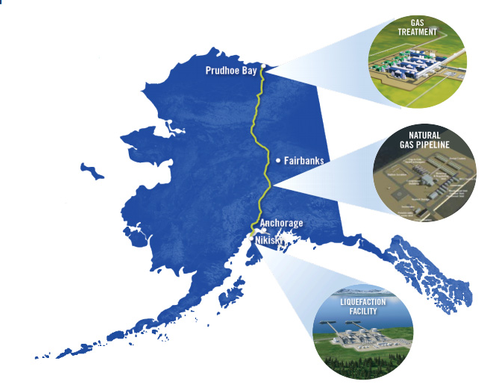MONDAY, NOVEMBER 13, 2017
An agreement with state-owned corporations in China may revive a major natural gas pipeline project in Alaska that had been all but abandoned as of a year ago.
The Alaska LNG project, a pipeline that would convey natural gas 800 miles from the North Slope to the Alaskan coast, was the subject of an agreement signed Thursday (Nov. 9) during President Donald J. Trump’s visit with China President Xi Jinping. The China Petrochemical Corporation (Sinopec), CIC Capital Corporation and the Bank of China signed on to work with the Alaska Gasline Development Corporation—an Alaska state-owned entity—on a marketing and investment plant for Alaska LNG.

 |
| AGDC |
|
The pipeline would transport natural gas from the North Slope to a liquefaction facility near Anchorage. |
Alaska LNG, estimated to cost between $45 billion and $65 billion, was in jeopardy last fall, when BP, ConocoPhillips and ExxonMobil all pulled out of the project amid falling liquefied natural gas prices. Conoco and BP later entered into new agreements with AGDC, to assist in the development of the project.
Natural Gas to China
According to AGDC, the new agreement with China includes work on marketing, financing, an investment model and China content for the project. Sinopec said that it is “interested in the possibility of LNG purchase on a stable basis from Alaska LNG.”
According to the Associated Press, the agreement entails about 75 percent of the liquefied natural gas transported by the pipeline being exported to China, with 25 percent remaining in Alaska. Rapidly developing China, the world’s most populous nation, is turning more to natural gas, which effects less air pollution, in lieu of coal.
Project History
Alaska’s state government began working toward a major natural gas pipeline project in 2009. The AGDC was formed in 2013, and Alaska LNG was authorized in 2014.
 |
| Marcin Klapczynski, CC BY-SA 3.0, via Wikimedia Commons |
|
Alaska LNG would be an 800-mile, 42-inch natural gas pipeline. (Pipeline pictured is an older oil pipeline in Alaska.) |
As proposed, Alaska LNG would be an 800-mile, 42-inch natural gas pipeline operating at 2,075 PSIG. Proponents predict an average throughput of 3.1 billion cubic feet per day. AGCD says the pipeline will supply “a stable supply of natural gas for Alaskans,” and drive industry in the state. The corporation plans off-take facilities and local distribution systems to transport gas from the main line to local users.
Additional facilities would include a three-train liquefaction plant at Nikiski, on the Cook Inlet near Anchorage, and a gas treatment plant on the North Slope, the northernmost tier of the state. LNG bound for China would be shipped via LNG carrier tankers, which would be loaded at a marine terminal at the liquefaction plant.
The North Slope
The North Slope includes the National Petroleum Reserve-Alaska and Prudhoe Bay, both major production sites for petroleum products. Prudhoe Bay is the source of more than 70 percent of Alaska’s discovered natural gas resources.
The region borders the Arctic National Wildlife Refuge, where drilling is not allowed. In May, Secretary of the Interior Ryan Zinke initiated action to potentially expand drilling in the NPRA and part of ANWR.
The Alaska LNG project will have to go through federal, state and local permitting processes before construction can begin; AGCD hopes that with the proper approvals, construction will start in 2019 for completion in the mid-2020s.
Tagged categories: Government; Infrastructure; Oil and Gas; Pipelines; Program/Project Management